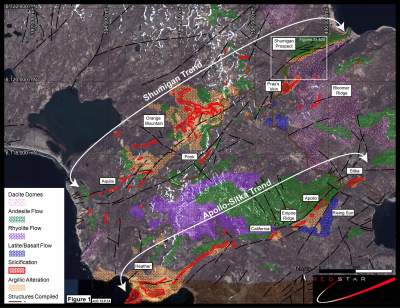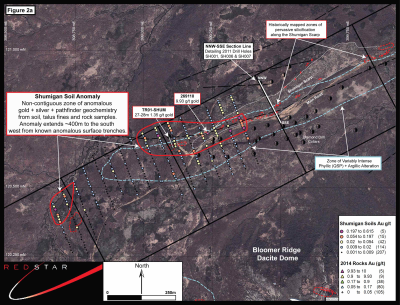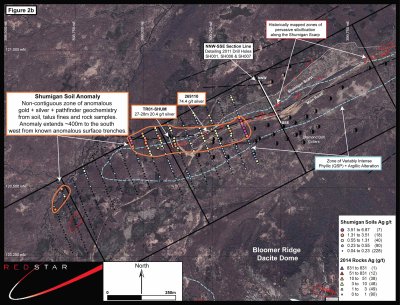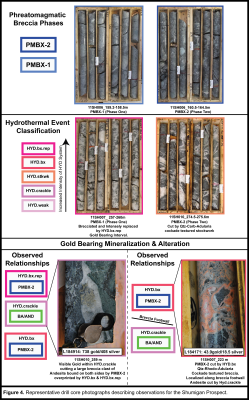Redstar extends known surface mineralization along the Shumigan Trend at its 100%-owned Unga Gold Project, Alaska

Evidence of a larger, district-scale epithermal and magmatic-related gold system
Vancouver, Canada / TNW-ACCESSWIRE / Redstar Gold Corp. / (TSX.V:RGC) ("Redstar" or the "Company") is pleased to announce further encouraging results from its 100%-owned Unga Gold Project, where the Company is exploring for high-grade, epithermal gold mineralization within an historic mining camp located on Unga Island in the Aleutian Arc of Alaska.
Continuing from the Company's recently announced results for work performed along the Apollo-Sitka Trend (see December 11, 2014 news release), the new results show further high-grade gold and silver results in rock samples, while positive soil and talus sampling results extend zones of known mineralization along the Shumigan Trend (Figure 1).
Redstar President and CEO, Toby Mayo, commented: "We continue to receive encouraging results at our Unga Gold Project in Alaska, which add to our understanding of the geological system as a whole, most notably a demonstrable relationship between phreatomagmatic breccias and high-grade gold mineralization as part of a larger, district-scale epithermal-magmatic related system. This exciting development has opened up additional avenues of exploration into what could be a significantly larger system than previously thought. Furthermore, the work of reinterpreting historic core and geological data has provided us with additional insight and exploration targets which will help guide our upcoming drilling campaign for early in 2015."
The Apollo-Sitka and Shumigan Trends, both located along the southeast portion of Unga Island, are partially fault-controlled, northeast to southwest oriented semi-linear trends that transect the entirety of Unga Island. Each is more than 7,500 m long. Areas of intense alteration, and precious and base metal vein systems define both trends.
As announced previously, all results from the 2014 surface program have now been received from ALS Chemex Laboratories in Vancouver. Results from the surface program, along with ongoing data compilation and auditing, are being used in the planning of a core-drilling program planned for early 2015.
Shumigan Trend: 2014 surface program results
Redstar's recently completed surface sampling program tested two prospective areas along the Shumigan Trend, both known to host previously-documented mineralization: the Shumigan and Aquila Prospects. Overall results show the potential for additional mineralized areas within the vicinity of the sampling areas, as established by positive soil and talus sampling results.

Click Image To View Full SizeFigure 1. Schematic geological map highlighting prospective trends along the southeastern portion of Unga Island, Alaska
At Shumigan, a soil sample grid of approximately 750 m by 200 m was oriented to test the western extension of known surface and sub-surface mineralization along inferred structures, as documented by historic geological maps and trench data (Figures 2a and 2b). Results from the survey show a gold and silver geochemical soil signature of 20 to 50 ppb Au (up to 615 ppb Au) and >0.5 g/t Ag (up to 6.8 g/t Ag) that has been defined over areas of historical trenching. This anomaly has been extended to the southwest by approximately 400 m, where anomalous values occur along the southwestern flank of a low lying ridge that abuts against an active, north draining flood plain.
Rock chip sampling produced results of up to 9.93 g/t Au and 74.4 g/t Ag from quartz vein breccias and stockwork that occur in surface outcrops.
At the Aquila Prospect, at the far western end of the Shumigan Trend (Figure 1), a series of reconnaissance soil lines placed within upland areas covering strong argillic alteration zones produced scattered results of approximately 50 ppb Au (up to 197ppb Au) and 0.5 to 1.3 g/t Ag (up to 3.51 g/t Ag). A single select rock sample of a narrow breccia vein sampled within an intense argillic alteration zone produced results of 90.2 g/t Ag.

Click Image To View Full SizeFigure 2a. Anomalous gold in soil and select rock samples from the Shumigan prospect.

Click Image To View Full SizeFigure 2b. Anomalous silver in soil and select rock samples from the Shumigan prospect.
Geological re-interpretation of the Shumigan Prospect
In preparation for diamond drill targeting at Shumigan, Redstar performed an in-depth review of the Shumigan prospect, including: (1) compilation of all historic data from various sources; (2) a detailed audit of the historical assay database; (3) locating and re-surveying historic drill collars and drill roads; and (4) a detailed review of all existing geological data related to historic drill core for the project.
The geological architecture of the Shumigan prospect has been described previously as a series of veins and vein breccias situated along a faulted contact between flat-lying basaltic/andesite flows (footwall) and phyllic-altered air-fall tuffs, flows and volcaniclastic sediments (hanging wall). After a detailed review of the existing drill core, Redstar has observed evidence of a phreatomagmatic (hydrothermal-magmatic) breccia system interpreted to be intimately associated with a nearby dacitic, hypabyssal dome mapped along Bloomer Ridge (Figure 1).
At depth, hanging wall quartz-feldspar-biotite phyric dacite gradually changes into a wide (5 m to more than 40 m) zone of steeply-standing, multi-phase breccia bodies that are localized along the Shumigan Scarp (Figure 3a). The Shumigan Scarp is interpreted as a pre-existing structure that facilitated emplacement of the breccias, as well as acting as a buttress to epiclastic sediments (e.g., reworked volcanic rocks, mudstone, shale, carbonaceous beds and volcanic tuffs/flows) that were deposited within a valley separating the Shumigan Scarp from Bloomer Ridge (Figures 1 and 3a).
---------------------------------------------------------------------------------------------------------------------------------------------------
|Click Image To View Full Size
|Click Image To View Full Size
|
|
|
|
|-------------------------------------------------------------------------------------------------------------------------------------------------|
|Figure 3a.Schematic cross-section highlighting observed
relationships|Figure 3b.Schematic cross-section highlighting observed
relationships |
|associated with phreatomagmatic breccia phases at the Shumigan
|associated with precious metal bearing hydrothermal systems at the
Shumigan|
|Prospect.
|Prospect.
|
---------------------------------------------------------------------------------------------------------------------------------------------------
The breccias contain a variety of lithic fragments consisting of primary igneous rock, fragments of silicified country-rock, phyllic-altered country rock, older breccia bodies, and a variety of hydrothermal vein types (Figure 4). Matrix material to the breccia phases vary from hydrothermal to intrusive, but most matrix phases exhibit euhedral biotite and fine grained black-gray hydrothermal quartz ? adularia.

Click Image To View Full Size
The phreatomagmatic breccia phases are interpreted to be pre- to syn-mineralization. A protracted multi-phase, anastomosing and bifurcating, precious metal-bearing quartz ? carbonate (rhodochrosite) + adularia hydrothermal system is part of, and is superimposed upon the breccia phases (Figures 3b and 4). Variable levels of intensity within the hydrothermal system either intensely replaced and/or re-brecciated the phreatomagmatic breccias by open space veins, vein breccias and stockwork zones exhibiting crustiform, cockade and banded textures (Figures 3b and 4). At depths of between 30 m to 105 m below sea level, the hydrothermal system (as well as the breccia bodies) widens and bifurcates and exhibits an increase in stockwork veining within the hanging wall to the breccia system (Figure 3b). Above this level, the hydrothermal system narrows and has been telescoped up section along the footwall and along specific breccia phases.
Sulfide minerals are not common; however, when present they occur as very fine-grained pyrite, sphalerite, galena, visible gold and blue-grey metallic sulfides locally within crustiform layers or in stockwork and crackle breccia systems (Figure 4). Pervasive phyllic alteration (quartz-sericite-pyrite), zones of variable silicification, quartz-adularia-carbonate stockworks and patchy disseminated pyrite occurs throughout the breccia and outbound into the hanging wall overprinting epiclastic sediments and dacite (Figure 3b).
The Unga district
Along the Shumigan and Apollo-Sitka Trends, as well as in other parts of the district, broad zones of intense argillic alteration that halo pervasive silicification, commonly seen to obliterate original host-rock volcanic textures, is a well-documented geological feature.
Statistical analyses of gridded soil, talus fines and select rock samples from the 2014 surface program suggest a combination of hydrothermal-related and magmatic-related geochemical signatures. This corroborates our identification of magmatic-related hydrothermal breccias associated with high-grade gold mineralization at Shumigan.
Redstar's fieldwork indicates that the Unga district is a well-endowed gold-silver system, where localized high-grade mineralization may be a part of a larger, intrusive-related magmatic system(s) with the potential to yield additional exploration targets at depth and elsewhere within the district. This assessment is based on the recognition of: (1) dacitic hypabyssal domes located between the Shumigan and Apollo-Sitka trends; (2) broad zones of argillic alteration, silicification, and quartz-adularia stockworks and veins localized along regional structures and near dacitic dome margins; (3) an association of molybdenum and potassium in geochemical samples, as well as visible biotite within zones of anomalous geochemistry; (4)-- a combination of hydrothermal and magmatic geochemical signatures; and (5) the association between phreatomagmatic breccias and precious metal-bearing hydrothermal systems.
Quality assurance and control
The 2014 surface program and sampling protocol was managed and carried out by Redstar's geological staff and its consultants. All work was supervised directly by Jesse C. Grady, Redstar's Vice President of Exploration. A quality assurance/quality control ("QA/QC") protocol was used which included the random insertion of standard reference samples at the frequency of approximately one standard for every twenty samples delivered to the assay laboratory. All surface samples were securely shipped to ALS Chemex Laboratories in Fairbanks, Alaska for preparation, with fire assay and multi-element ICP analyses carried out at ALS Chemex Laboratories facility in Vancouver, British Columbia.
Qualified person
Jesse C. Grady, MSc, CPG-11592, the Company's Vice President of Exploration is a qualified person within the meaning of National Instrument 43-101. Mr. Grady has reviewed and approved the technical content of this news release.
About the 2014 surface program
Redstar initiated a surface sampling program that was completed in September 2014 (see press releases from June 24, August 12 and October 27, 2014). The program was generated to understand the surface geochemical signature and geological controls to mineralization on two major trends: (1) the Apollo-Sitka Trend; and (2) the Shumigan Trend, with the primary goal of defining areas outside of the known zones of mineralization that could warrant additional detailed exploration. The program followed the finalization of a surface use agreement between Redstar and the Unga Village Corporation that granted Redstar overland access use.
At the Shumigan Prospect, approximately 12 select rock samples, and 43 continuous chip trench samples covering approximately 44 m of historic trenches were taken. A total of 383 soil/talus fine samples were collected on a grid covering an area of approximately 750 m of strike length by more than 200 m width, and covering the western-most extensions of the Shumigan prospect area.
At Aquila, reconnaissance soil lines totaling 155 soil/talus fine samples were collected along a widely spaced grid covering 1,700 m of strike length, where intense zones of argillic alteration define the Shumigan Trend.
About RedStar Gold Corp.
Redstar is a Vancouver based junior exploration company focused on high-grade gold exploration in North America. Each of Redstar and Confederation Minerals Ltd. (TSX.V:CFM) owns 50% of the Newman Todd Project, located in Red Lake, Ontario, Canada. In Alaska, the Company is exploring the high-grade Unga Project, which it acquired initially in 2011. At Unga, a comprehensive exploration program commenced in late July 2014, and results will be used to determine drill targets for a first phase diamond drill program. Additionally, the Company has ten properties in Nevada, which have been optioned to True Grit Resources Ltd. (NEX:TGI.H).
Renmark Financial Communications Inc.
Robert Thaemlitz: rthaemlitz@renmarkfinancial.com
Richard Dupuy: rdupuy@renmarkfinancial.com
Tel.: (416) 644-2020 or (514) 939-3989
www.renmarkfinancial.com
On Behalf of the Board,
Redstar Gold Corp.
"Toby Mayo"
Toby Mayo
President and CEO
-----------------------------------------------------------------------------
|TSX.V:RGC WWW.REDSTARGOLD.COM|CORPORATE INQUIRIES
|
|SUITE 615 |Redstar Gold Corp.
|
|800 WEST PENDER STREET |Paul Durham, Manager of Investor
Relations|
|VANCOUVER, BC |Tel: 203.940.2538
|
|TEL: 604.488.0051 |Toll Free:1.877.310.3330
|
| |pdurham@redstargold.com
|
-----------------------------------------------------------------------------
Forward-Looking Information This news release contains "forward-looking information" within the meaning of applicable Canadian securities laws. Such information includes, but is not limited to, information regarding proposed exploration activities and prospects. Although the Company believes that such information is reasonable, it can give no assurance that such expectations will prove to be correct. Forward-looking information is typically identified by words such as: "expects", "plans", "anticipates", "believes", "intends", "estimates", "projects", "potential" and similar expressions, or that events or conditions "will", "would", "may", "could" or "should" occur. Although the Company believes the expectations expressed in such forward-looking information are based on reasonable assumptions, such statements are not guarantees of future performance and actual results may differ materially from those expressed or implied by such forward-looking information. Factors that could cause actual results to differ materially from those in the forward-looking information include, but are not limited to: general business, economic, competitive, political and social uncertainties; the actual results of current exploration activities; timing and availability of external financing on acceptable terms; future prices for gold or other minerals; accidents, labour disputes and other risks of the mining industry; and delays in obtaining governmental approvals, required financing or in the completion of activities, as well as those risks identified in the Company's filings with the Canadian securities regulators, which may be viewed at www.sedar.com. Except as may be required by applicable securities laws, the Company disclaims any intention or obligation to update any forward-looking statement, whether as a result of new information, future events or results, or any other occurrence. Readers are cautioned not to place undue reliance on forward-looking information.
Neither TSX Venture Exchange nor its Regulation Services Provider (as that term is defined in the policies of the TSX Venture Exchange) accepts responsibility for the adequacy or accuracy of this release.
Copyright (c) 2014 TheNewswire - All rights reserved.




